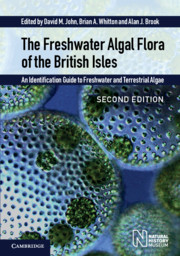 The Freshwater Algal Flora of the British Isles
The Freshwater Algal Flora of the British Isles Published online by Cambridge University Press: 12 January 2024
Stimulated by curiosity about the natural diversity of his environment, collecting, describing and identifying examples of different types of organisms has been the pursuit of scientists and amateur collectors for centuries. In the case of microalgae, these studies rapidly advanced in the late nineteenth and early twentieth centuries, coinciding with developments in microscopy. This subsequently led to the publication of comprehensive algal guides such as West and Fritsch’s A Treatise on the British Freshwater Algae (1927). In most cases field material was examined, and field samples remain the starting point for the description and identification of new taxa. However, although the study of field material is of paramount importance for many taxonomic, biodiversity and ecological studies, there are limitations to the scientific, and for that matter biotechnological, exploitability of these samples. Algal cultures provide workers with defined, in some cases axenic, reproducible materials. These cultures, when appropriately documented, are, in effect, ‘biological standards’ on which much of the published algal-related science, ecotoxicology and commercial exploitation are built. Furthermore, without defined algal cultures, reproducible, comparative, developmental, physiological, molecular and other studies would be at best problematic to perform.
The first report on laboratory-based algal culturing dates from 1850, when Ferdinand Cohn, one of the founders of bacteriology, maintained a non-clonal, but probably unialgal, culture of Haematococcus pluvialis. Subsequently, workers in Russia successfully maintained green algae in artificial defined mineralbased medium (Famintzin, 1871), with the first clonal, axenic cultures maintained on defined medium being attributed to Beijerinck in the 1890s (see Preisig and Andersen, 2005). At least one Beijerinck culture from this time, Chlorella vulgaris CCAP 211/11B, which is employed in ecotoxicology (OECD, 1984), has been continuously maintained by serial transfer since 1892. Furthermore, the use of clonal cultures has subsequently become the standard approach for most laboratory studies.
Algal cultures are routinely serial subcultured using aseptic microbiological techniques. In most cases this involves transferring an inoculum from a late log or early stationary phase culture into fresh, presterilized medium. The objective is to retain a healthy, physiologically, morphologically and genetically representative specimen that can be used at short notice. A key factor to be considered is that different ages of subcultures may provide different stages of the life cycle (e.g. aplanospores in addition to green dividing and motile cells in early stationary phase cultures of Haematococcus pluvialis).
To save this book to your Kindle, first ensure [email protected] is added to your Approved Personal Document E-mail List under your Personal Document Settings on the Manage Your Content and Devices page of your Amazon account. Then enter the ‘name’ part of your Kindle email address below. Find out more about saving to your Kindle.
Note you can select to save to either the @free.kindle.com or @kindle.com variations. ‘@free.kindle.com’ emails are free but can only be saved to your device when it is connected to wi-fi. ‘@kindle.com’ emails can be delivered even when you are not connected to wi-fi, but note that service fees apply.
Find out more about the Kindle Personal Document Service.
To save content items to your account, please confirm that you agree to abide by our usage policies. If this is the first time you use this feature, you will be asked to authorise Cambridge Core to connect with your account. Find out more about saving content to Dropbox.
To save content items to your account, please confirm that you agree to abide by our usage policies. If this is the first time you use this feature, you will be asked to authorise Cambridge Core to connect with your account. Find out more about saving content to Google Drive.